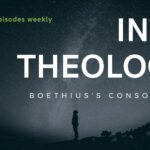For many evangelicals, the Holy Spirit has become a forgotten friend. We know that he is real, but he hovers outside our experience. He haunts us. We sometimes feel him but never see him. He lives somewhere above us, but we struggle to know how to live with him down here. In short, he is a ghost—always haunting us, speaking through us, living in us, and never quite known to us.
For this reason, we owe it to ourselves to discover who the Holy Spirit is and to understand how he lives in us. He is life to us. We need to learn how he is this for to us.
The Creed Tells Us Who the Holy Spirit Is
The Niceno-Constantinopolitan Creed (AD 381) famously says: “we believe … in the Holy Ghost, the Lord and Giver of life, who proceedeth from the Father, who with the Father and the Son together is worshiped and glorified, who spake by the prophets” (from the Nicene Creed). At the centre of historical Christianity lie these words concerning the Spirit.
Far from being a mere philosophical summary, the Creed itself summarizes the Bible. Each line corresponds to a Bible verse or to a concept in the Bible. For example, the Holy Spirit is called “the Lord” just as Paul says, “the Lord is the Spirit” (2 Cor 3:17). “Giver of life” corresponds to John 6:63 in which Jesus says that “The Spirit gives life” (NIV).
The language of procession comes right from the Bible too. Jesus says that the Spirit “proceeds from the Father” (John 15:26). The glory given to the Holy Spirit corresponds to the language of God’s glory scattered throughout Scripture as well as Peter’s phrase, “the Spirit of glory” (1 Pet 4:14).
The phrase “spake by the prophets” fits into the common pattern of prophets speaking by the Holy Spirit. For example, Jesus says that David spoke in the Spirit (Matt 22:43), agreeing with the testimony David himself: “The Spirit of the Lord spoke through me; his word was on my tongue” (2 Sam 23:2).
The Niceno-Constantinopolitan Creed shows Christians how to line up the Bible’s message into a coherent picture for the purpose of confessing God. It is not, as some might assume, Greek philosophy put to work. It is biblical theology richly informing the church.
Learning of the Lord, the Giver of Life
A good place to start our study of the Holy Spirit, then, is the creed itself. It represents about three-hundred years of Spirit-filled Christians working together to know the Holy Spirit. Each line of the creed draws us to the Scripture where we can find inspired truths.
As the creed pulls us to Scripture, it also lines up titles and phrases about the Spirit strategically to paint a vivid picture of the Lord, the Giver of Life—the Spirit who signifies the seal of God’s unrelenting love upon us.
After grasping the picture the creeds draws, continue in Scripture to expose the contours of the credal picture of the Spirit. Then dive even deeper. Learn directly from God who his Spirit is.
We complete our learning of the Spirit in prayer. When we read Scripture, we hear God speak. When we pray, God hears us speak. It is a two-way conversation in which the Spirit uniquely works because “the Spirit helps us in our weakness. For we do not know what to pray for as we ought, but the Spirit himself intercedes for us with groanings too deep for words” (Rom 8:26).
Creed, Scripture, prayer. Keeping in mind that the creed represents meditations on the meaning of Scripture by Spirit-filled men of God, we can conclude that these three tools will reveal that the Spirit never haunted us. He was always with us, praying alongside us, and teaching us the Way of the faith.












